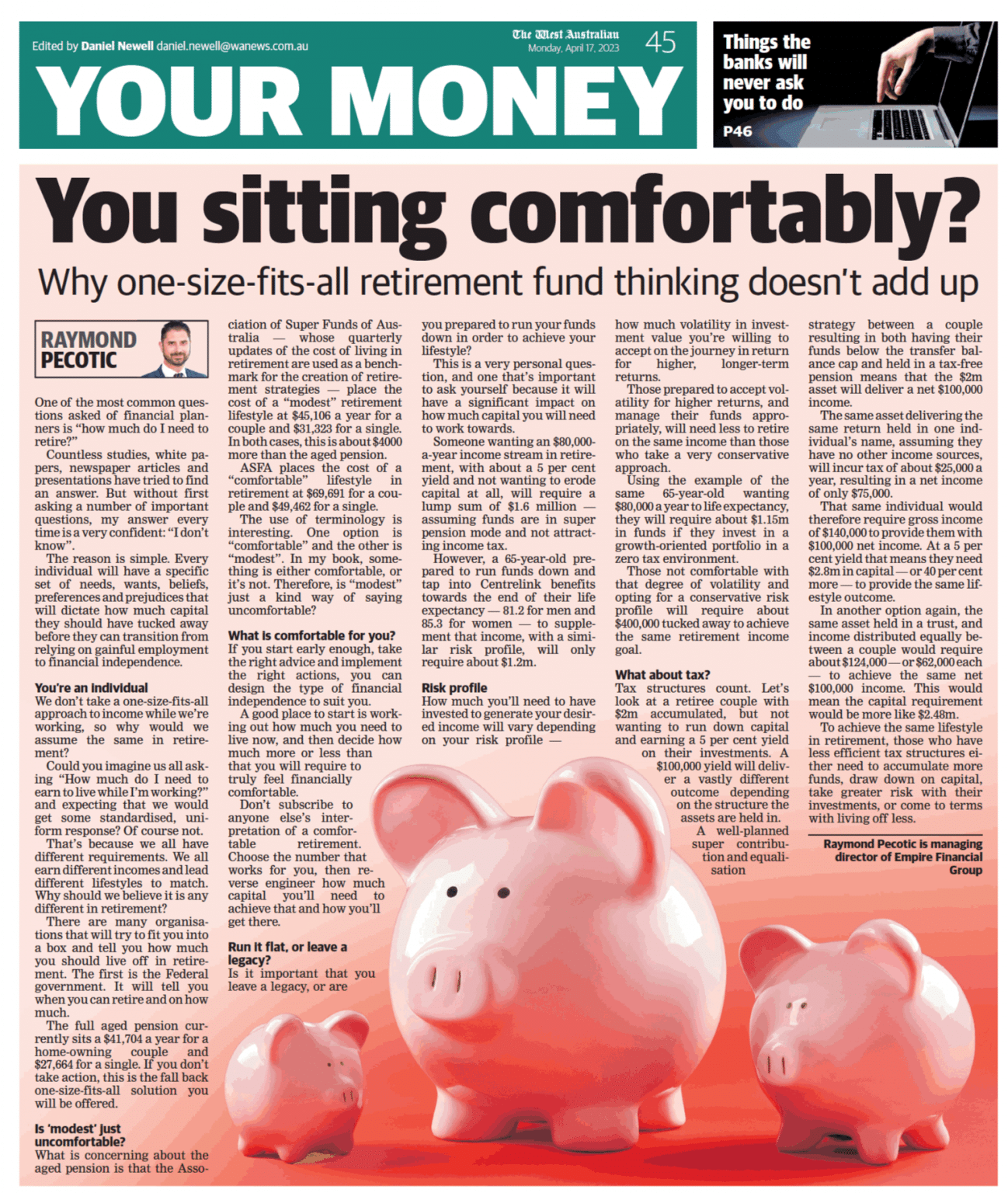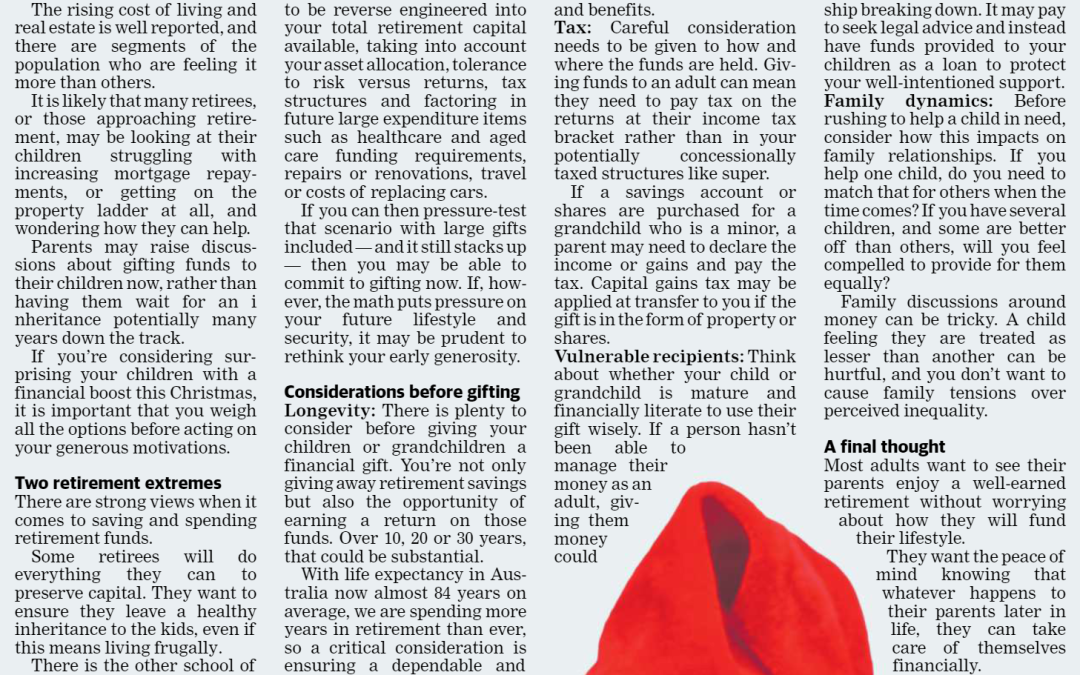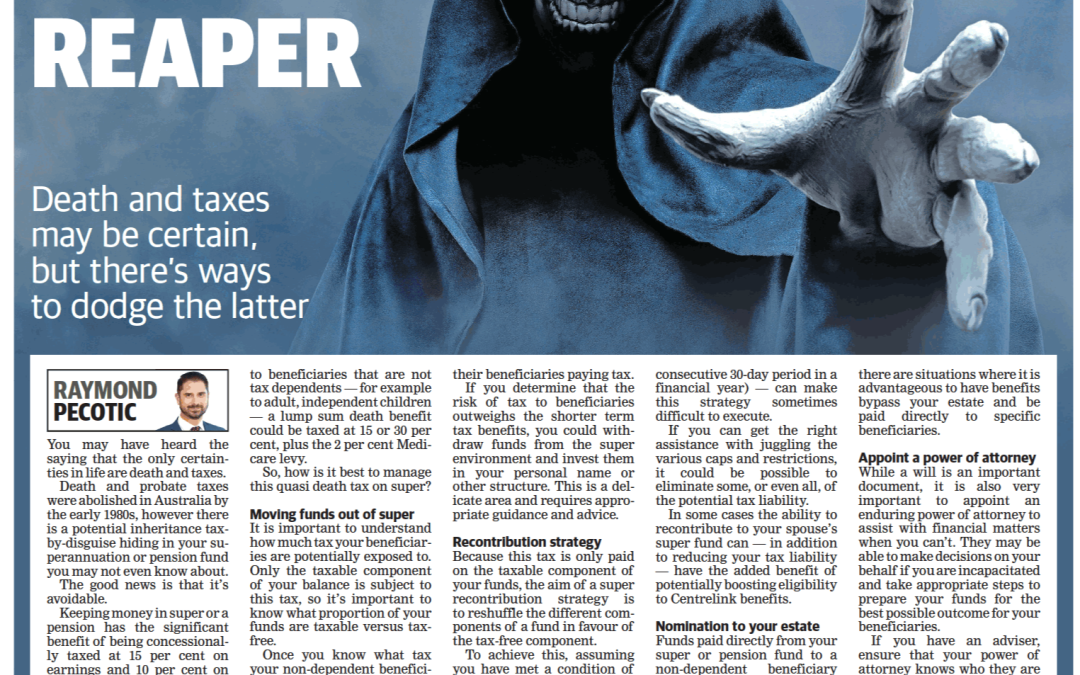This article first appeared in The West Australian, Your Money, 17 April 2023
One of the most common questions asked of financial planners is, “how much do I need to retire?”
Countless studies, white papers, newspaper articles and presentations have tried to find an answer. But without first asking a number of important questions, my answer every time is a very confident: “I don’t know”.
The reason is simple. Every individual will have a specific set of needs, wants, beliefs, preferences and prejudices that will dictate how much capital they should have tucked away before they can transition from relying on gainful employment to financial independence.
You’re an individual
We don’t take a one-size-fits-all approach to income while we’re working, so why would we assume the same in retirement?
Could you imagine us all asking “How much do I need to earn to live while I’m working?” and expecting that we would get some standardised, uniform response? Of course not.
That’s because we all have different requirements. We all earn different incomes and lead different lifestyles to match. Why should we believe it is any different in retirement?
There are many organisations that will try to fit you into a box and tell you how much you should live off in retirement. The first is the Federal government. It will tell you when you can retire and on how much.
The full aged pension currently sits a $41,704 a year for a home-owning couple and $27,664 for a single. If you don’t take action, this is the fall back one-size-fits-all solution you will be offered.
Is ‘modest’ just uncomfortable?
What is concerning about the aged pension is that the Association of Super Funds of Australia — whose quarterly updates of the cost of living in retirement are used as a benchmark for the creation of retirement strategies — place the cost of a “modest” retirement lifestyle at $45,106 a year for a couple and $31,323 for a single. In both cases, this is about $4000 more than the aged pension.
ASFA places the cost of a “comfortable” lifestyle in retirement at $69,691 for a couple and $49,462 for a single.
The use of terminology is interesting. One option is “comfortable” and the other is “modest”. In my book, something is either comfortable, or it’s not. Therefore, is “modest” just a kind way of saying uncomfortable?
What is comfortable for you?
If you start early enough, take the right advice and implement the right actions, you can design the type of financial independence to suit you.
A good place to start is working out how much you need to live now, and then decide how much more or less than that you will require to truly feel financially comfortable.
Don’t subscribe to anyone else’s interpretation of a comfortable retirement. Choose the number that works for you, then reverse engineer how much capital you’ll need to achieve that and how you’ll get there.
Run it flat, or leave a legacy?
Is it important that you leave a legacy, or are you prepared to run your funds down in order to achieve your lifestyle?
This is a very personal question, and one that’s important to ask yourself because it will have a significant impact on how much capital you will need to work towards.
Someone wanting an $80,000-a-year income stream in retirement, with about a 5 per cent yield and not wanting to erode capital at all, will require a lump sum of $1.6 million — assuming funds are in super pension mode and not attracting income tax.
However, a 65-year-old prepared to run funds down and tap into Centrelink benefits towards the end of their life expectancy — 81.2 for men and 85.3 for women — to supplement that income, with a similar risk profile, will only require about $1.2m.
Risk profile
How much you’ll need to have invested to generate your desired income will vary depending on your risk profile —
how much volatility in investment value you’re willing to accept on the journey in return for higher, longer-term returns.
Those prepared to accept volatility for higher returns, and manage their funds appropriately, will need less to retire on the same income than those who take a very conservative approach.
Using the example of the same 65-year-old wanting $80,000 a year to life expectancy, they will require about $1.15m in funds if they invest in a growth-oriented portfolio in a zero tax environment.
Those not comfortable with that degree of volatility and opting for a conservative risk profile will require about $400,000 more tucked away to achieve the same retirement income goal.
What about tax?
Tax structures count. Let’s look at a retiree couple with $2m accumulated, but not wanting to run down capital and earning a 5 per cent yield on their investments. A $100,000 yield will deliver a vastly different outcome depending on the structure the assets are held in. A well-planned super contribution and equalisation
strategy between a couple resulting in both having their funds below the transfer balance cap and held in a tax-free pension means that the $2m asset will deliver a net $100,000 income.
The same asset delivering the same return held in one individual’s name, assuming they have no other income sources, will incur tax of about $25,000 a year, resulting in a net income of only $75,000.
That same individual would therefore require gross income of $140,000 to provide them with $100,000 net income. At a 5 per cent yield that means they need $2.8m in capital — or 40 per cent more — to provide the same lifestyle outcome.
In another option again, the same asset held in a trust, and income distributed equally between a couple would require about $124,000 — or $62,000 each — to achieve the same net $100,000 income. This would mean the capital requirement would be more like $2.48m.
To achieve the same lifestyle in retirement, those who have less efficient tax structures either need to accumulate more funds, draw down on capital, take greater risk with their investments, or come to terms with living off less.
Raymond Pecotic is the Managing Director of Empire Financial Group



